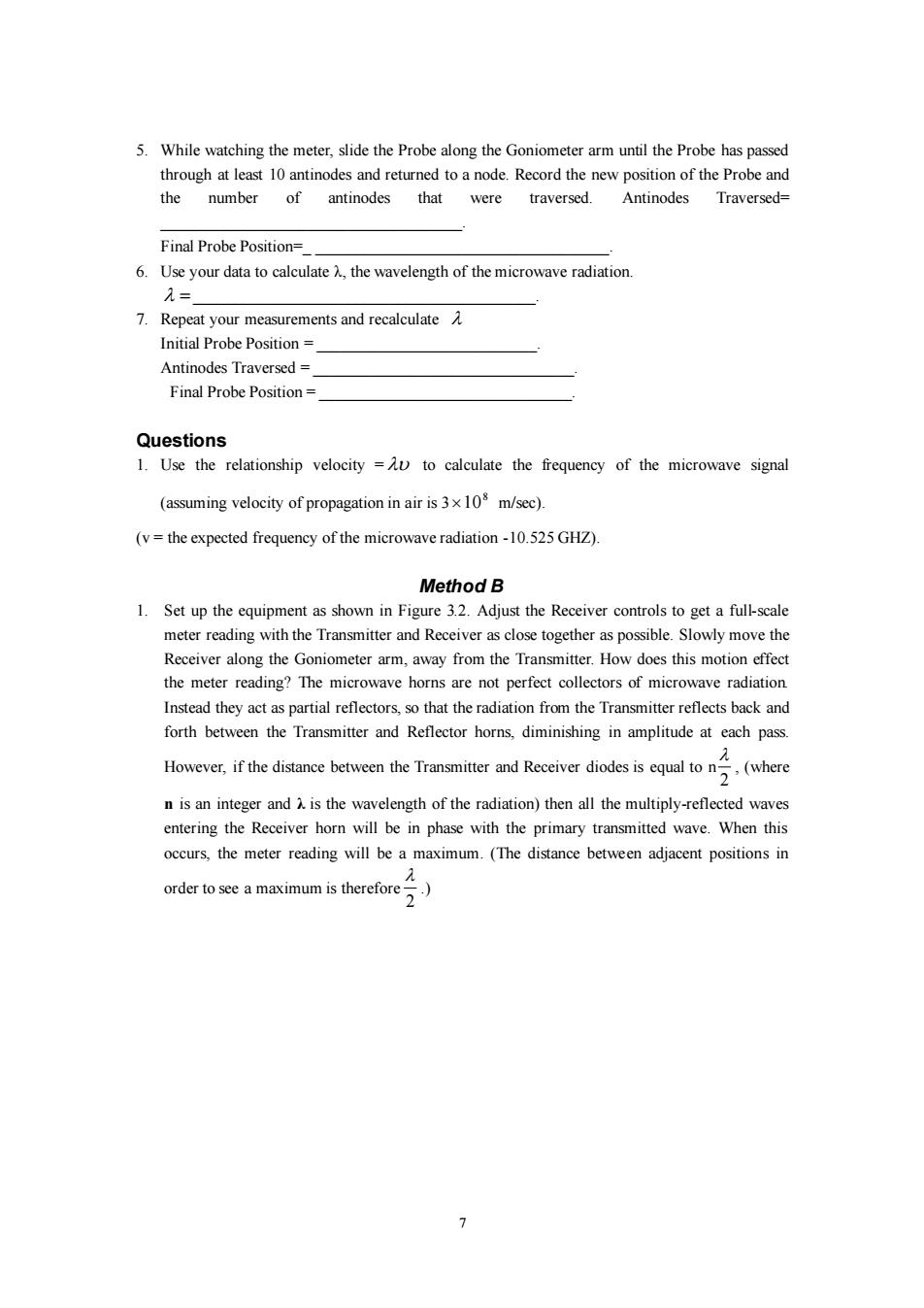正在加载图片...

5.While watching the meter,slide the Probe along the Goniometer arm until the Probe has passed through at least 10 antinodes and returned to a node.Record the new position of the Probe and the number of antinodes that were traversed. Antinodes Traversed= Final Probe Position= 6.Use your data to calculate A,the wavelength of the microwave radiation. 九= 7.Repeat your measurements and recalculateA Initial Probe Position Antinodes Traversed Final Probe Position= Questions 1.Use the relationship velocity =u to calculate the frequency of the microwave signal (assuming velocity of propagation in air is 3x108 m/sec). (v=the expected frequency of the microwave radiation-10.525 GHZ). Method B 1.Set up the equipment as shown in Figure 3.2.Adjust the Receiver controls to get a full-scale meter reading with the Transmitter and Receiver as close together as possible.Slowly move the Receiver along the Goniometer arm,away from the Transmitter.How does this motion effect the meter reading?The microwave horns are not perfect collectors of microwave radiation Instead they act as partial reflectors,so that the radiation from the Transmitter reflects back and forth between the Transmitter and Reflector horns,diminishing in amplitude at each pass. λ However,if the distance beteen the Trnsmiter and Receiver diodes is quto(where n is an integer and A is the wavelength of the radiation)then all the multiply-reflected waves entering the Receiver horn will be in phase with the primary transmitted wave.When this occurs,the meter reading will be a maximum.(The distance between adjacent positions in order to see a maximum is therefore-.) 2 >7 5. While watching the meter, slide the Probe along the Goniometer arm until the Probe has passed through at least 10 antinodes and returned to a node. Record the new position of the Probe and the number of antinodes that were traversed. Antinodes Traversed= _____________________________________. Final Probe Position=_ ____________________________________. 6. Use your data to calculate λ, the wavelength of the microwave radiation. =__________________________________________. 7. Repeat your measurements and recalculate Initial Probe Position = ___________________________. Antinodes Traversed = ________________________________. Final Probe Position = _______________________________. Questions 1. Use the relationship velocity = to calculate the frequency of the microwave signal (assuming velocity of propagation in air is 3 8 10 m/sec). (v = the expected frequency of the microwave radiation -10.525 GHZ). Method B 1. Set up the equipment as shown in Figure 3.2. Adjust the Receiver controls to get a full-scale meter reading with the Transmitter and Receiver as close together as possible. Slowly move the Receiver along the Goniometer arm, away from the Transmitter. How does this motion effect the meter reading? The microwave horns are not perfect collectors of microwave radiation. Instead they act as partial reflectors, so that the radiation from the Transmitter reflects back and forth between the Transmitter and Reflector horns, diminishing in amplitude at each pass. However, if the distance between the Transmitter and Receiver diodes is equal to n 2 , (where n is an integer and λ is the wavelength of the radiation) then all the multiply-reflected waves entering the Receiver horn will be in phase with the primary transmitted wave. When this occurs, the meter reading will be a maximum. (The distance between adjacent positions in order to see a maximum is therefore 2 .)